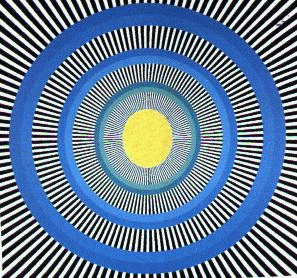Stephen Macknik, PhD, director of the Laboratory of Behavioral Neurophysiology; Susana Martinez-Conde, PhD, director of the Laboratory of Visual Neuroscience; Xoana G. Troncoso, PhD; and Jorge Otero-Millan; conducted a study based on the Enigma painting, a visual illusion in which rotational motion is seen within a stationary image. The artwork has been at the center of a debate over whether the brain or the eye is behind the perception of illusory motion.
Dr. Martinez-Conde's laboratory recently discovered that microsaccades, a small, unconscious eye movement that occurs when humans fixate their eyes, are critical to normal vision. The team of scientists conducted the Enigma study to see if microsaccades are also behind the perception of this illusion. Based on their study, the hypothesis suggesting the illusion originates solely in the brain was ruled out.

The Enigma, created by op-artist Isia Leviant
Participants in the study observed the Enigma illusion while their eye movements were simultaneously recorded with high precision cameras. Microsaccade rates increased before the illusionary motion sped up and decreased before the motion slowed, revealing a direct link between the eye movements and the illusion.
"We have discovered that this illusion originates with eye movements and not solely the brain as previously thought," says Dr. Martinez-Conde. "The findings from the study could help design future prosthetics for patients with brain damage or brain lesions that affect the perception of motion."
Article: Xoana G. Troncoso, Stephen L. Macknik, Jorge Otero-Millan, and Susana Martinez-Conde, 'Microsaccades drive illusory motion in the Enigma illusion', Published online before print October 8, 2008, doi: 10.1073/pnas.0709389105 PNAS October 14, 2008 vol. 105 no. 41 16033-16038






Comments